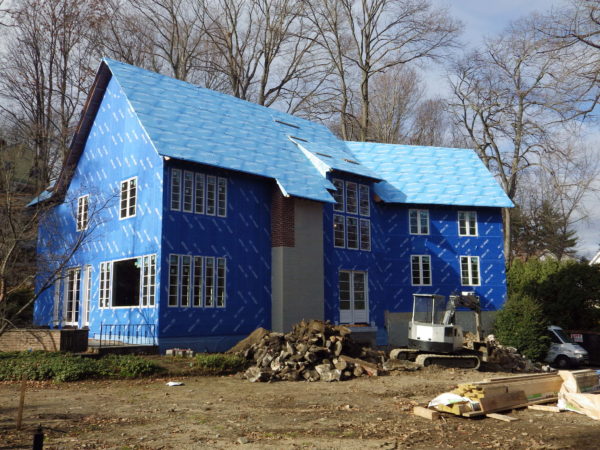Mystery solved.
Sabine H. Schoenberg is the person behind the rubbernecking and rapidly applied brakes on Old Church Road in Greenwich. You never saw a blue house quite so blue, even in some pastel-mad beach community, though for this house it”™s just its skivvies, soon to disappear under siding and roofing.
The 100-percent, basement-to-topmost-crest sheathing saves on energy consumption while helping to make fresh the home”™s interior air, an uptrending concern in homebuying.
Schoenberg has been a designer, real estate developer and Realtor since 1988. She runs two Greenwich-based websites: the Fairfield County real estate-based PrimeSitesCT.com and ThisNewHouse.com, which offers videos on themes that include better lighting, cleaner air, better use of space and use of new-to-the-market materials. It is, she narrates, “the place to find new products and trends in building to nurture your body and your spirit.” ThisNewHouse is currently focused on the blue house on Old Church Road.
Schoenberg sees several trends represented in the blue house.
First, she said, is its location. “It”™s closer to town. It”™s in the right place as far as the market pulse is concerned.”
She said the market drivers today are downsizing baby boomers and millennials, who together create a like-minded cohort of health-conscious consumers.
“The boomers are very aware of health issues and are very focused on health,” she said. “The millennials, who are the kids of the boomers, are taking eco-friendly to a whole new level. It”™s not about bigger is better, but better is better. These are the big groups I am seeing in Westchester and Fairfield counties.
“They want less maintenance,” she said. “They want ease of use. And they want the products that allow them to do these things. Working with clients, I see these trends playing out right before my eyes.”
Millennials, she said, are presenting the market with fresh criteria on their checklists.
“For them, they grew up with recycling; being eco-friendly is completely natural,” she said. Their concerns include the “smart use” of materials, including warp-resistant laminated wood that eliminates building-site waste. Today”™s lighting is LED, though the windows, for reasons of eco-friendliness more than charm, are often wood-framed.
As for the air, “Our houses are the most polluted spaces we find ourselves in,” Schoenberg said.
“The old thinking was to create a tight environment,” she said. “”™Don”™t heat the great outdoors”™ or whatever was said. The idea was that the inside stayed inside.”
The blue sheathing on Old Church Road, made by California-based Henry Co., said Schoenberg, “goes on like peel-n-place wallpaper, with overlap; you wrap the entire house.” She said it is an air-and-water barrier that breathes and that previously had been a commercial product. She said the Old Church Road project is the first regionally for the Henry sheathing. She self-produced a video of its ability to endure punctures ”” such as roofing nails ”” and self seal. She called it “a very high-tech product.”
“You can see people slamming on their brakes for a look,” she said. “There has been a lot of interest.”
She expects such easily applied sheaths to be the norm in five years. “There”™s no question in my mind,” she said. “When something is better, it”™s just better.”
She said talk of financial layout and payback are highly variable, influenced by the type of heating system, the type of insulation and the habits of the homeowner.
The blue house and others now coming to market are built with energy-recovery systems. In this scenario, internal air is harvested of its cooling or heating energy and then expelled. The house takes in fresh outside air, which can be filtered to one”™s desires. Of the blue house, Schoenberg said, “Healthy is a big part of this house.”
The Old Church Road property will use a geothermal system drilled to a depth of 450 feet for temperature control.
“Never mind the quality of the air, with this house, huge amounts of energy will be saved,” Schoenberg said, estimating the blue house would be about 80 percent more efficient than a comparable house 50 years ago. “A simple example would be an incandescent light bulb vs. an LED. That”™s how big the changes are.”
Schoenberg buttressed her case with a raft of national data, including National Association of Realtors findings that said one-third of homebuyers during Q1 2014 were millennials. Additionally, she said, from 2015 to 2025, Harvard University”™s Joint Center for Housing Studies predicted 24 million millennials starting new households. She cited a Better Homes & Gardens survey that found 57 percent of millennials believing smart technology is a good investment in their homes, as opposed to 35 percent of respondents 55 and above. And, also referencing Better Homes & Gardens, she said 59 percent of millennials believe smart technology can be integrated into their personal style, taste and decor as opposed to 29 percent of respondents 55 and above.
When complete, the blue house will be clapboard with a stone base.




















Love it!